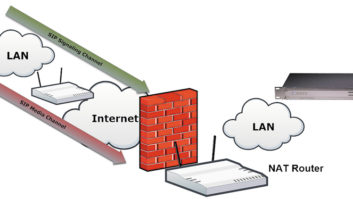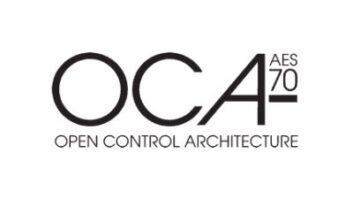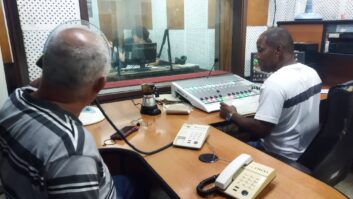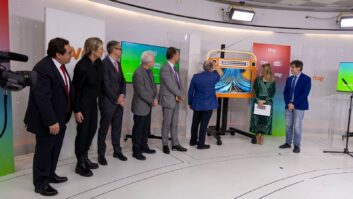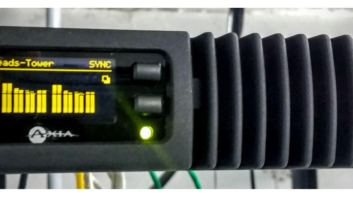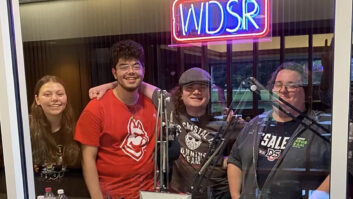Broadcast Engineering Conference
- Tuesday morning April 15: “New Technologies for Radio Listening”
- Tuesday afternoon April 15: “Audio Over IP”
- Tuesday afternoon April 15: “Next-Generation Public Alerting”
With HD Radio in bloom as the 2008 NAB Show draws near, the technical sessions at the Broadcast Engineering Conference are particularly topical.
NEW TECH
Tuesday morning’s offerings are grouped under the general heading of “New Technologies for Radio Listening,” chaired by Steve Fluker, director of engineering for the Cox Radio cluster in Orlando, Fla. Fluker says the topics to be presented are timely, considering the level of interest in, and rapid adoption of, HD Radio.
“This session is all about introducing engineering and operations personnel to real-life issues that will have to be faced when implementing IP and other new technical systems.”
“For example, Junius Kim’s presentation titled ‘Utilizing IP Networks for Seamless Simulcasting Over Multiple Transmitters’ is all about keeping various multicast sites in sync. In an all-analog world, this was not even a consideration, but with blended HD and analog signals, plus stations’ frequent reliance on boosters and translators, synchronization cannot be ignored.”
Even better, Fluker said, is the affordability of the solution. “Coupling IP connectivity with the accuracy of the GPS system for timing is an extremely reliable and cost-effective answer to a brand new issue for engineers.”
Kim is a senior engineer with Harris Corp. His presentation focuses on the problems that can arise when several transmitters all within range of a consumer’s receiver are not precisely synced up.
“Without a seamless handoff from one signal to the next, the receiver will update erratically, with predictable listener complaints,” Fluker said. The ubiquity of broadband IP networks, along with GPS enhanced timing, solves these problems.
Ask any program director what he or she lives and dies by, and the answer will almost always be “The numbers we got in the last book.”
(click thumbnail)A portion of two racks of equipment monitoring silence and Arbitron PPM encoding on some of Greater Media’s 22 audio streams in Philadelphia. From Larry Paulausky’s presentation.With the rollout of Arbitron’s new Portable People Meter technology starting in Philadelphia last year, the new answer is likely to be “the accuracy of our PPM encoding signal.”
Fluker is particularly excited to host Larry Paulausky’s presentation on this topic. In “Practical Considerations of Radio Broadcast Operations in an Arbitron PPM Market,” Paulausky, chief engineer of Greater Media, shares issues and solutions to monitoring and correcting problems with the Arbitron encoded signal.
PPM technology is intended ultimately to replace the diary methodology and utilizes pager-sized receivers, carried by survey participants, that decode sub-audible signals superimposed on a station’s main audio. The decoded signal is translated into a rating for the station and reported back.
“Everyone knows about Arbitron’s PPM technology, but less well known is what happens when the encoder goes off-line,” says Fluker. “What are the practical implications? How quickly should an engineer address the problem, especially if the failure occurs coincidentally with a major transmitter outage?”
Fluker believes most engineers would address the transmitter issue first and work on the encoder later, but he says that would be a mistake.
“Engineers in PPM markets need to know that the PPM encoder is just as important to the station’s operation as the transmitter, and that is what this presentation is all about.”
“Can you hear me now?” is more than just a tag line for a cell phone commercial. It’s the main question most engineers would like to ask the listening public with regard to their station’s signal.
To that point, NPR Senior Technologist John Kean and Dr. Ellyn G. Sheffield of NPR Labs and Towson State University conducted an in-depth study on this subject, drilling down to specifics such as overall sound quality, annoyance of background noise and whether or not the conditions presented would result in “listener fatigue.” Their presentation is “Consumer Ratings of Impaired Audio at Various Signal/Noise Ratios.”
Again, Fluker expects information that might be counterintuitive to the broadcast engineer.
“As a group, I suspect we are way more attuned to audio degradation,” he says. “I personally cringe at some MP3 audio our stations get, but the listeners don’t even seem to notice. I also hope to see the effects of digitally induced noise on the analog signal, because let’s face it, that signal is still where the lion’s share of the money is made today.”
The data presented by the NPR team will provide engineers an opportunity to see how objective SNR measurements correlate with actual listener opinion under controlled conditions.
Providing data services to paying customers is one avenue to the elusive “second revenue stream” broadcasters openly covet. Alexander Zink of Fraunhofer IIS will outline the current deployment of datacasting in the United States and Europe in a session titled “Data Services for Digital Broadcasting.” As well, Zink will detail his company’s partnerships in maximizing the revenue potential of such services.
“More and more stations are going to be providing data services,” Fluker said, “but right now, no one seems to know how to monetize the investment in the technology.” What will consumers want, and more importantly, what will they pay for?
And in a presentation that could be called “Phone Lines Are So Last Century,” the morning rounds out with a presentation that is actually “Affordable IP-Based Remote Monitoring and Control of Transmitter Sites.”
Johannes Rietschel, CEO and founder of Barix AG, states that, in addition to stations no longer needing dedicated phone lines for remote control and monitoring, neither do those stations or groups need to install and maintain completely redundant servers along with peripherals and static IP addresses.
“Cox is a very big proponent of this technology,” says Fluker, whose own cluster in Orlando relies on it. Customized applications running on off-the-shelf hardware can be paid for by the month, and offer a variety of alarm and notification options.
“We not only monitor traditional transmitter functions,” he said, “but we also have developed a whole suite of additional features, right down to streaming back monitor audio from the sites for better troubleshooting capability.” It’s a tutorial on 21st century command and control alternatives.
IP AUDIO
Tuesday afternoon at the Broadcast Engineer Conference highlights “Audio Over IP” with session chair Talmage Ball, vice president of engineering for Bonneville Broadcasting.
Sending audio streams over the Internet is a core application for radio stations these days. The ubiquity of broadband Internet connections coupled with powerful compression algorithms available in high-quality codecs make using the Net as a general-purpose transport mechanism a vital tool for radio broadcasters.
Johannes Rietschel of Barix resumes the podium with “IP-Based Audio and Control Distribution Over Internet Satellite and Wireless Platforms.” Focusing on the details of synchronizing metadata with main stream audio and the plethora of secondary applications this technology supports, he will discuss pros and cons of using RTP vs. Shoutcast methodology.
Rietschel explores limitations of relying on third-party public servers, given the somewhat unpredictable bottlenecks these portals have exhibited in the past. If you are a current IP audio distributor or just want to check out the advisability of putting your airstream on IP transport, this is a session to attend.
RRDP-EE is not a new specialized electrical engineering degree. Rather, it stands for “Rapid Radio Deployment Pack — Emergency Edition,” and the ins and outs of this new technology will be discussed.
The concept is designed to bring the horsepower of a full-featured news operation into the field with minimal notice. Also, in an age of unexpected evacuations, having facilities that can be moved and assembled with ease can help an operations engineer sleep better.
Pierre Robidoux, senior engineer with CBC Canada, will discuss considerations that must be addressed when assembling a RRDP-EE package, which are more significant than might be assumed.
Switching between network feeds and local programming, allowing for special news bulletins and maintaining contact with other remote locations are among the programming issues involved. The presentation also will cover technical aspects of the project such as designing modular audio production units for different needs, command and control issues, such as basic automation and communication units, and the correct IP transport strategy; using public or private networks. An interesting session for the post-9/11 world.
Steve Church, president of Telos Systems, presents “Advanced Tech for IP Remotes.” Not long ago, broadcasters had few choices when deciding how to transport audio from the field back to the studio, mainly telco POTS lines or VHF/UHF radio. POTS lines, of course, were the lowest of low fidelity, and narrow-band FM radios required licenses and the all-important “line-of-sight” shot. Then along came ISDN and remotes grew up.
As Church explains it, ISDN has served broadcasters well. In fact, he says, it was a small-scale revolution when it appeared. For the first time, the dial-up network could be used for high-fidelity remotes. Compared to equalized analog “broadcast loops” that had been the only high-fidelity telephone service, ISDN was a miracle.
Still, ISDN has some drawbacks, and technology has moved on. Church discusses the pros and cons of managing remote audio via IP transport over the Internet. Broadcast codecs, taking advantage of new technology and optimized for the real-world conditions on IP networks, make this practical.
ACTUALLY, THIS ISN’T A TEST
The nation’s emergency alerting system, in its various incarnations, has had a checkered past, going all the way back to the Nuclear Cold War days of the 1950s, when it was known as CONELRAD (which stood for CONtrol of ELectromagnetic RADiation).
“Next-Generation Public Alerting” is a session that will focus on where this system is going and how the implementation will affect broadcasters and the public.
The chairman is Clay Freinwald, corporate engineer with Entercom. Given the problems with the manual and semi-automatic systems of the past, as well as the fact that EAS violations are high up on the FCC’s list of station fines, this session is topical.
Scheduled to take part in the one-hour panel are Edward Czarnecki, senior vice president of SpectraRep, Jerry LeBow, co-chairman of Sage Alerting Systems and Darryl Parker, senior vice president of TFT.






